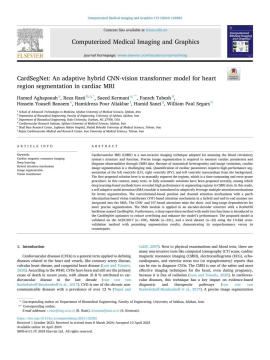MeCardnet: A Novel Multi-Scale Convolutional Ensemble Model with Adaptive Deep Supervision for Precise Cardiac MRI Segmentation
Hamed Aghapanah a , Reza Rasti b,c,**, Faezeh Tabesh d , Hamidreza Pouraliakbar e , Hamid Sanei d , Saeed Kermani a,*
a Department of Bioelectrics and Biomedical Engineering, School of Advanced Technologies in Medicine, Isfahan University of Medical Sciences, Isfahan, Iran b Department of Biomedical Engineering, Faculty of Engineering, University of Isfahan, Isfahan, Iran c Department of Biomedical Engineering, Duke University, Durham, NC 27708, USA d Cardiovascular Research Institute, Isfahan University of Medical Sciences, Isfahan, Iran e Rajaie Cardiovascular Medical and Research Center, Iran University of Medical Sciences, Tehran, Iran
ABSTRACT
Accurate segmentation of the left ventricle, right ventricle, and myocardium is essential for estimating key cardiac parameters in diagnostic procedures. However, automating Cardiovascular Magnetic Resonance Imaging (CMRI) segmentation faces challenges from diverse imaging vendors and protocols. This study introduces MECardNet framework as an innovative multiclass CMRI segmentation model, representing a prominent advancement in the field. MECardNet leverages a Multiscale Convolutional Mixture of Experts (MCME) ensemble technique with Adaptive Deep Supervision, seamlessly integrated into the U-Net architecture. The MCME framework improves representation learning in the U-Net workflow. It does this by adaptively adjusting the contribution of U-Net layers in the ensemble for better data modeling. Additionally, MECardNet incorporates a cross-additive attention mechanism, an EfficientNetV2L backbone, and a specialized compound loss function, leading to enhanced model performance. Through 10-fold Cross-Validation (CV) analysis on the ACDC dataset, MECardNet surpasses baseline models and state-of-the-art methods, showcasing promising performance levels with evaluation metrics such as Dice Similarity Coefficient (DSC) of 96.1 ± 0.4 %, Jaccard coefficient of 92.2 ± 0.4 %, Hausdorff distance of 1.7 ± 0.1 and mean absolute distance of 1.6 ± 0.1. Further validation on the M&Ms-2 dataset and a local dataset confirms promising performance of MECardNet, with DSC of 94.3 ± 0.7 % and 94.5 ± 0.6 %, respectively. The proposed MECardNet framework establishes a new benchmark in CMRI segmentation by outperforming existing models, offering efficient and reliable computer-aided technologies for cardiovascular disease diagnosis, with the potential for significant impact in the field. Researchers can access MECardNet repository and results on GitHub1 for comprehensive
Keywords: Adaptive Deep Supervision Cardiac MRI Segmentation Deep Learning Ensemble of Attentions Mixture of Experts
_________________________________________________________________________________________________________________________________________
___________________________________________________________________________________________________________________________________________
CardSegNet: An adaptive hybrid CNN-vision transformer model for heart region segmentation in cardiac MRI
Hamed Aghapanah a,, Reza Rasti b,c,*, Saeed Kermani a,**, Faezeh Tabesh d,
Hossein Yousefi Banaem e, Hamidreza Pour Aliakbarf, Hamid Sanei d, William Paul Segars b
a School of Advanced Technologies in Medicine, Isfahan University of Medical Sciences, Isfahan, Iran b Department of Biomedical Engineering, Faculty of Engineering, University of Isfahan, Isfahan, Iran c Department of Biomedical Engineering, Duke University, Durham, NC 27708, USA d Cardiovascular Research Institute, Isfahan University of Medical Sciences, Isfahan, Iran e Skull Base Research Center, Loghman Hakim Hospital, Shahid Beheshti University of Medical Sciences, Tehran, Iran f Rajaie Cardiovascular Medical and Research Center, Iran University of Medical Sciences, Tehran, Iran
ABSTRACT
Cardiovascular MRI (CMRI) is a non-invasive imaging technique adopted for assessing the blood circulatory system’s structure and function. Precise image segmentation is required to measure cardiac parameters and diagnose abnormalities through CMRI data. Because of anatomical heterogeneity and image variations, cardiac image segmentation is a challenging task. Quantification of cardiac parameters requires high-performance segmentation of the left ventricle (LV), right ventricle (RV), and left ventricle myocardium from the background. The first proposed solution here is to manually segment the regions, which is a time-consuming and error-prone procedure. In this context, many semi- or fully automatic solutions have been proposed recently, among which deep learning-based methods have revealed high performance in segmenting regions in CMRI data. In this study, a self-adaptive multi attention (SMA) module is introduced to adaptively leverage multiple attention mechanisms for better segmentation. The convolutional-based position and channel attention mechanisms with a patch tokenization-based vision transformer (ViT)-based attention mechanism in a hybrid and end-to-end manner are integrated into the SMA. The CNN- and ViT-based attentions mine the short- and long-range dependencies for more precise segmentation. The SMA module is applied in an encoder-decoder structure with a ResNet50 backbone named CardSegNet. Furthermore, a deep supervision method with multi-loss functions is introduced to the CardSegNet optimizer to reduce overfitting and enhance the model’s performance. The roposed model is validated on the ACDC2017 (n=100), M&Ms (n=321), and a local dataset (n=22) using the 10-fold crossvalidation method with promising segmentation results, demonstrating its outperformance versus its counterparts.
Keywords:
Cardiac magnetic resonance imaging ,Deep learning ,Hybrid attention mechanism ,Image segmentation , Vision transformer


